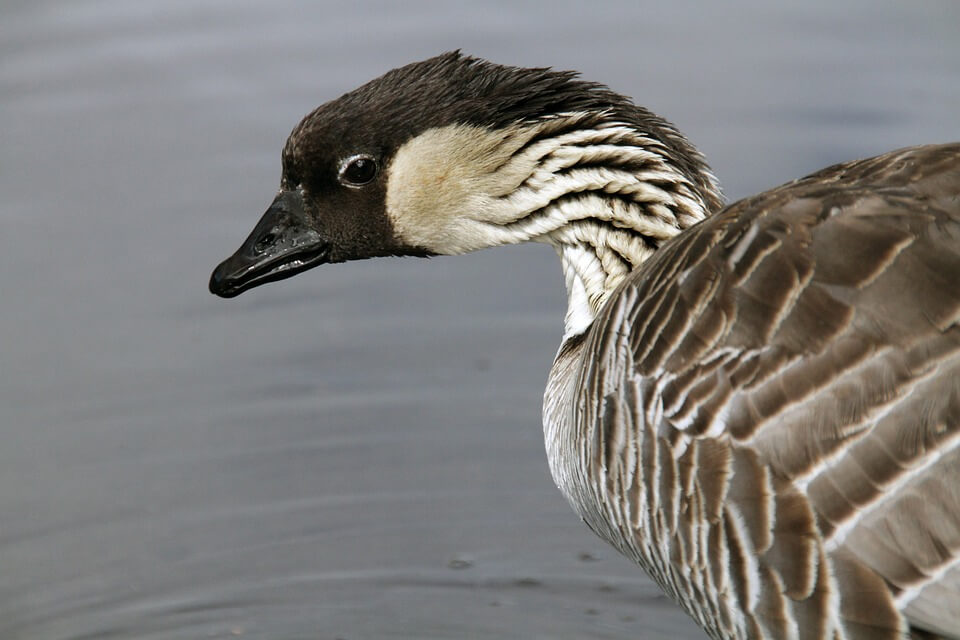Information about Nene Goose (Branta sandvicensis). What kind of animal is Nene Goose (Branta sandvicensis)? In which regions does it live? What are its features?

Source: pixabay.com
The Nene Goose (Branta sandvicensis) is a species of bird that is endemic to the Hawaiian Islands. It is a member of the goose family, Anatidae, and is also known as the Hawaiian Goose. The Nene Goose is the official state bird of Hawaii.
The Nene Goose is a medium-sized bird, with a body length of about 61 cm (24 inches) and a wingspan of about 1.2 meters (4 feet). It has a dark brown to black plumage with distinctive white feathers on its cheeks and throat. The bill and legs are black.
The Nene Goose is herbivorous and feeds mainly on leaves, seeds, and fruits. It is also known to eat insects and snails. The breeding season for the Nene Goose begins in August and lasts until March, during which time it builds a nest of grass and lays an average of three to five eggs.
The Nene Goose is considered endangered due to habitat loss, hunting, and introduced predators such as rats, cats, and mongoose. However, conservation efforts have been successful in increasing the population of this species.
Taxonomy
Kingdom: Animalia
Phylum: Chordata
Class: Aves
Order: Anseriformes
Family: Anatidae
Genus: Branta
Species: B. sandvicensis
The Nene Goose (Branta sandvicensis) belongs to the family Anatidae, which includes ducks, geese, and swans. It is a member of the genus Branta, which comprises several species of geese, and its specific epithet, “sandvicensis,” refers to the Hawaiian Islands, where this species is endemic.
Nene Goose (Branta sandvicensis) Appearance and Physical Characteristics
The Nene Goose (Branta sandvicensis) is a medium-sized bird with a distinctive appearance and physical characteristics.
- Size: The adult Nene Goose is about 61 cm (24 inches) in length and has a wingspan of about 1.2 meters (4 feet).
- Plumage: The plumage of the Nene Goose is dark brown to black with white feathers on its cheeks and throat. It has a black bill and black legs. The white feathers on its cheeks and throat are more pronounced in males than females.
- Body Shape: The Nene Goose has a streamlined body shape that is adapted to its flight and swimming capabilities.
- Weight: Adult Nene Geese weigh around 1.4 to 2.3 kg (3.1 to 5.1 lb), with males being slightly larger and heavier than females.
- Sexual Dimorphism: The male Nene Goose is generally larger and heavier than the female, and also has more pronounced white feathers on its cheeks and throat.
Overall, the Nene Goose is a distinctive and elegant bird, with a unique appearance that sets it apart from other geese species. Its physical characteristics are adapted to its environment and help it survive in the Hawaiian Islands, where it is endemic.
Popular Culture
The Nene Goose is not as well-known in popular culture as some other bird species, but it has made a few appearances in literature, film, and other media. Here are some examples:
- Literature: The Nene Goose is featured in the children’s book “The Hawaiian Goose” by Marion Coste and illustrated by Robert Lyn Nelson. The book tells the story of a young boy who helps a group of Nene Geese migrate to a safer place.
- Film: The Nene Goose appears briefly in the 2011 Disney film “The Muppets,” during a musical number called “Life’s a Happy Song.”
- Mascot: The Nene Goose is the official state bird of Hawaii and is used as a mascot for various organizations, including the University of Hawaii at Hilo and the Hawaii Nature Center.
- Conservation Efforts: The Nene Goose has been the subject of numerous conservation efforts to protect and preserve the species. These efforts have been featured in various documentaries and news stories over the years.
Overall, the Nene Goose may not be a well-known bird species in popular culture, but it has played a significant role in conservation efforts in Hawaii and is an important symbol of the state’s unique ecosystem.
Habitat
The Nene Goose (Branta sandvicensis) is endemic to the Hawaiian Islands and has a restricted range within the archipelago. Historically, the species was found throughout the Hawaiian Islands, including on the islands of Hawaii, Maui, Molokai, Kauai, and Oahu. However, due to habitat loss and hunting, the population declined dramatically, and by the mid-20th century, the Nene Goose was on the brink of extinction.
Today, the Nene Goose is primarily found in the higher elevation grasslands and shrublands of the island of Hawaii, as well as on Maui and Kauai. The species prefers open areas with low-growing vegetation, such as grasses, sedges, and herbs, as well as areas with shrubs and trees for roosting and nesting.
The Nene Goose is adapted to a variety of habitats, including volcanic slopes, lava fields, and coastal plains. The species is often found in areas that are not suitable for agriculture or urban development, as these activities can negatively impact the bird’s habitat and food sources.
Conservation efforts have helped to protect and restore some of the Nene Goose’s habitat, and the species has been successfully reintroduced to some areas where it had been extirpated. However, the Nene Goose is still considered an endangered species, and its habitat continues to be threatened by habitat loss, introduced predators, and other human activities.